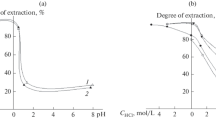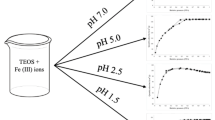Abstract
The physicochemical properties of silicas prepared from copper–nickel production tailings and modified with hydrazide functional groups were studied. The IR data confirm the presence of modifier functional groups on the surface of the initial silicas. The modifiers are assumed to be immobilized on the silica support by hydrogen bonding between the hydrazide carbonyl oxygen atom and silanol hydrogen atoms. Thermal analysis shows that the sorbents obtained are stable up to 220–250°С, whereas the initial hydrazides and dimethylhydrazides start to decompose at a lower temperature. The degrees of swelling of the initial and modified sorbents, the conditional ionization constants of the functional groups, and the isoelectric point were determined. Samples were chosen for further studies of the sorption of nonferrous and rare metals.



Similar content being viewed by others
REFERENCES
Chirkova, V.S., Sobgaida, N.A., and Rzazade, F.A., Vestn. Kazansk. Tekhnol. Univ., 2015, vol. 18, no. 20, pp. 263–266.
Zubkov, A.A., Bagrov, V.V., Kamrukov, A.S., Kostritsa, V.N., and Krylov, V.I., Vodooch. Vodopodgot. Vodosnabzh., 2020, no. 2 (146), pp. 36–44.
Lisichkin, G.V., Fadeev, A.Yu., Serdan, A.A., Nesterenko, P.N., Mingalev, P.G., and Furman, D.B., Khimiya privitykh poverkhnostnykh soedinenii (Chemistry of Grafted Surface Compounds), Moscow: Fizmatlit, 2003, pp. 38–56.
Habib, M., Hafida, M., Abdelkader, T., Caroline, B., and Anne, B., Sep. Purif. Technol., 2019, vol. 209, pp. 359–367. https://doi.org/10.1016/j.seppur.2018.07.035
Pozhidaev, Yu.N., Izv. Vyssh. Uchebn. Zaved., Prikl. Khim. Biotekhnol., 2014, vol. 4, no. 9, pp. 7–37.
Chukin, G.D., Khimiya poverkhnosti i stroenie dispersnogo kremnezema (Surface Chemistry and Structure of Dispersed Silica), Moscow: Paladin, 2008, pp. 5–17, 30–47, 119–147.
Lisichkin, G.V. and Olenin, A.Y., Russ. J. Gen. Chem., 2021, vol. 91, pp. 870–889. https://doi.org/10.1134/S1070363221050182
Tyukavkina, V.V., Kasikov, A.G., Gurevich, B.I., and Maiorova, E.A., Khim. Tekhnol., 2014, vol. 15, no. 3, pp. 167–172. https://doi.org/10.1134/S1070363221050182
Kasikov, A.G., Shchelokova, E.A., and Dvorniko-va, A.M., Sep. Sci. Technol., 2021, vol. 56, no. 2, pp. 242–251. https://doi.org/10.1080/01496395.2020.1718709
Timoshchik, O.A., Shchelokova, E.A., and Kasikov, A.G., Tr. Kol’sk. Nauchn. Tsentra Ross. Akad. Nauk, Ser. Khim. Materialoved., 2019, no. 3, pp. 368–375. https://doi.org/10.25702/KSC.2307-5252.2019.10.1.368-375
Il’ves, V.G., Zuev, M.G., Sokovnin, S.Yu., and Murzakaev, A.M., Phys. Solid State, 2015, vol. 57, no. 12, pp. 2512–2518. https://doi.org/10.1134/S1063783415120161
Elisee, N.B., Dominique, R., Carmen, M.N., and Gérald, J.Z., Environ. Sci. Pollut. Res., 2018, vol. 25, no. 29, pp. 7823–7833. https://doi.org/10.1007/s11356-017-1115-7
Slavinskaya, G.V. and Khokhlov, V.Yu., Potentsiometricheskoe titrovanie ionitov: Prakticheskoe rukovodstvo (Potentiometric Titration of Ion Exchangers: Practical Guide), Voronezh: Voronezhskii Gos. Univ., 2004, pp. 10–27. https://doi.org/10.1134/S1070363221050182
Neudachina, L.K., Pestov, A.V., Baranova, N.V., and Startsev, V.A., Anal. Kontr., 2011, vol. 15, no. 2, pp. 238–250. https://doi.org/10.1134/S1070363221050182
Batueva, T.D., Kondrashina, N.B., Kuz’micheva, N.D., Tiunova, T.G., and Shcherban’, M.G., Russ. J. Appl. Chem., 2017, vol. 90, no. 11, pp. 1746–1752. https://doi.org/10.1134/S1070427217110039
ACKNOWLEDGMENTS
The authors are grateful to Cand. Sci. (Chem.) A.G. Kasikov, head of laboratory of the Tananaev Institute of Chemistry and Technology of Rare Elements and Mineral Resources, Kola Scientific Center, Russian Academy of Sciences for making available the silica samples.
The study was performed using the equipment of the Center for Shared Use “Investigations of Materials and Substances,” Perm Federal Research Center, Ural Branch, Russian Academy of Sciences.
Funding
The study was financially supported by the Russian Science Foundation (project no. 20-69-46066).
Author information
Authors and Affiliations
Corresponding author
Ethics declarations
The authors declare that they have no conflict of interest.
Additional information
Translated from Zhurnal Prikladnoi Khimii, No. 7, pp. 910–918, July, 2022 https://doi.org/10.31857/S0044461822070106
Rights and permissions
About this article
Cite this article
Batueva, T.D., Zabolotnykh, S.A. & Chekanova, L.G. Physicochemical Properties of Silicas Modified with Hydrazide Functional Groups. Russ J Appl Chem 95, 1004–1011 (2022). https://doi.org/10.1134/S1070427222070114
Received:
Revised:
Accepted:
Published:
Issue Date:
DOI: https://doi.org/10.1134/S1070427222070114




